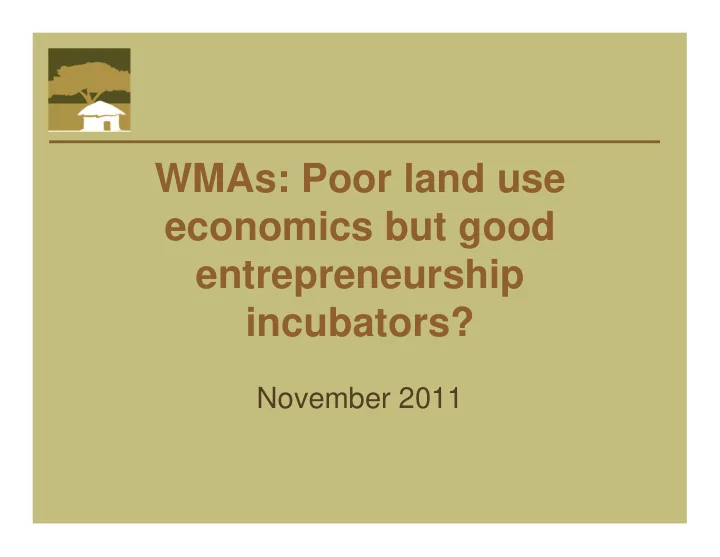

WMAs: Poor land use economics but good entrepreneurship incubators? November 2011
Introduction The Honeyguide Foundation is a non-profit, non governmental organization that supports Tourism- is it the ideal partner? communities and environmental conservation in Tanzania, making use of tourism as a sustainable source of income. The What other income generating Foundation’s focus areas are the following: options are there? • Improved and transparent community governance • Poverty alleviation Benefits, who and how? • Sustainable management of natural and socio- economic resources.
Tourism- is it the ideal partner?
Partnerships The Honeyguide Foundation is a non-profit, non Why is eco-tourism a natural partner for communities? governmental organization that supports • Talk of the day communities and environmental conservation • Sustainable business model in Tanzania, making use of tourism as a sustainable source of income. The • Local people benefit more- trickle down effect Foundation’s focus areas are the following: • Add value to tourism product-Eco journey • Improved and transparent community • Generates income and employment governance • Non-consumptive (for photographic) • Poverty alleviation • Participatory • Sustainable management of natural and socio- economic resources.
High end or low end 14 1600 % US $ 1400 12 international 1200 arrivals market 10 share 1000 8 tourism economy 800 share in GDP 6 600 4 400 international tourism receipts 2 200 by visitor 0 0
Setting the right environment • Tourism development support (marketing, infrastructure etc). • Innovation during planning-encourage low end tourism product in areas/zones of low value • Focus on high end in high value areas with caveat to employ local communities • External evaluating services for responsible tourism- such as RTTZ, STEP etc.
Can tourism provide? The Honeyguide Foundation is a non-profit, non Tourism provides the funds to make governmental organization that supports conservation a viable business venture for communities and environmental conservation communities to engage in. in Tanzania, making use of tourism as a • Loliondo [eastern Serengeti] in 2007 exceeded sustainable source of income. The $400,000 Foundation’s focus areas are the following: • Simanjiro, [east Tarangire] earned $20,000 in 2007 • Improved and transparent community • Sayari camp (northern Serengeti) in 2005 employed governance in 40% employees locally and 90% ( approx 40 • Poverty alleviation staff) in 2007 • Sustainable management of natural and socio- • Grumeti reserves purchased vegetable and salads economic resources. locally approx $30,000 per month
Fickle Flow 600 500 400 300 200 100 0 January February March April May june July august september october november december
Are there negative impacts? The Honeyguide Foundation is a non-profit, non Without an intelligent business governmental organization that supports approach, cultures and ecosystems can suffer: communities and environmental conservation in Tanzania, making use of tourism as a • Culture sustainable source of income. The • Immigration Foundation’s focus areas are the following: • Improved and transparent community • Expectations governance • Wealth • Poverty alleviation • Politics • Sustainable management of natural and socio- economic resources. • Ecosystems
Perfect partnership 1 - Lack economic income from tourism- little incentive for Conserving Community 1 communities. ecosystems development 2 - No consideration for 4 3 2 conservation, wildlife populations and habitat unsustainable. 3 - community not Tourism- onboard, no buy in to business conserve ecosystem. 4 - Harmonious balance.
Unbalanced partnership Tourism becomes the threat to Community conservation. Conserving development ecosystems Can have a negative effect on the communities. Tourism- Needs to be business managed well.
Incentive to Conserve Tourism $ reduced improve local protection economy and costs jobs improved NR improved management livelihoods
Income generating options?
Way of life • We need to recognise that CBNRM/ WMA’s are often not just “projects” that communities take up, but are very much a way of life, with grounding in history and tradition, even if many may actually be quite recent. • And we also need to convince and lobby governments to provide this respect and recognition.
Old is gold? • Traditional economic activities need to be improved (change?) to match new environmental conditions- in harmony with conservation objectives (capacity building and research). • New innovative SME’s are expensive to introduce and manage and need a min 5 years incubation.
Enduimet Facts 1,281 km 2 (twice 191 cattle/km 2 in wet season the size of Arusha 191 x 200$ = 38,200 $/km 2 N.P.) 38,200$/km 2 x 1281 km 2 = approx. 20,000 residents 49 million US$ 2,800 households
Think out the box for a minute.. 1% of the value of livestock capital (only cattle) sustained in a wet day in Enduimet would pay for one year of management
Can communities benefit? WMA’s Benefits NR Social Employment Security Governance Business Management Services Tourism Capacity Opportunity services (schools etc) Building +finance
Recommend
More recommend